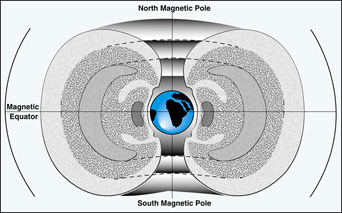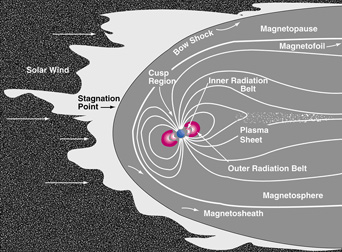Related module pages:
A Public Outreach Module:
Solar Wind, Genesis, and the Planets
The Earth's Magnetosphere
 The Earth’s magnetic field has two regions of very energetic charged particles that encircle the Earth like donuts. These regions are known as Van Allen radiation belts, named for the scientist who discovered them. The main constituent of the inner belt, which extends from an altitude of 2,000 to 5,000 kilometers above the Earth, is high-energy protons (H+), produced when cosmic ray ions collide with atoms of the atmosphere. The number of such ions is relatively small, and accumulates slowly in the inner belt. Because they are trapped in a stable region near the Earth, rather high intensities are reached, even though their build-up may take years. The Earth’s magnetic field has two regions of very energetic charged particles that encircle the Earth like donuts. These regions are known as Van Allen radiation belts, named for the scientist who discovered them. The main constituent of the inner belt, which extends from an altitude of 2,000 to 5,000 kilometers above the Earth, is high-energy protons (H+), produced when cosmic ray ions collide with atoms of the atmosphere. The number of such ions is relatively small, and accumulates slowly in the inner belt. Because they are trapped in a stable region near the Earth, rather high intensities are reached, even though their build-up may take years.
Further out, at an altitude of 15,000 km there is a region about 6,000 kilometers thick populated mostly by ions and electrons of much lower energy, produced by cosmic rays and magnetsopheric acceleration processes. The most energetic among these are also known as the "outer radiation belt."
Included in this mixture are "alpha particles" (He2+), which are found in the solar wind, and a small percentage of O+ ions. The most energetic of these ions, most of which are electrons, are also known as te "outer radiation belt." Unlike the inner belt, this population fluctuates widely.
The Earth's magnetic field has two poles, north and south, but the fields' pull extends far beyond the surface of the Earth. An average of 50 tons of plasma per day in this field flows against the gravitational pull of the Earth, much as the solar wind flows away from the sun. This plasma contains hydrogen, helium, oxygen and nitrogen atoms and ions.
 The Earth's magnetosphere and the solar wind do not interact smoothly. When the solar wind plasma flows past the Earth, it has difficulty penetrating the planet's magnetic field, leading to the creation of a huge bow-shaped shock wave. The bow shock, which marks the limit of the Earth's magnetic influence, occurs where the velocity of solar wind particles decreases from supersonic to subsonic speeds. The Earth's magnetosphere and the solar wind do not interact smoothly. When the solar wind plasma flows past the Earth, it has difficulty penetrating the planet's magnetic field, leading to the creation of a huge bow-shaped shock wave. The bow shock, which marks the limit of the Earth's magnetic influence, occurs where the velocity of solar wind particles decreases from supersonic to subsonic speeds.
The solar wind plasma comes closest to the center of the Earth at the stagnation point, where the planet's magnetic field repulsive force equals the solar wind's pressure. The position of the stagnation point depends on the solar-wind pressure, but it is usually about 64,000 kilometers (10 times the Earth's radius) out from the side of the planet facing the sun.
NEXT
For a more technical description, take a Closer Look at
The Structured Sun and Solar Max: At the Core of the Matter.

|
